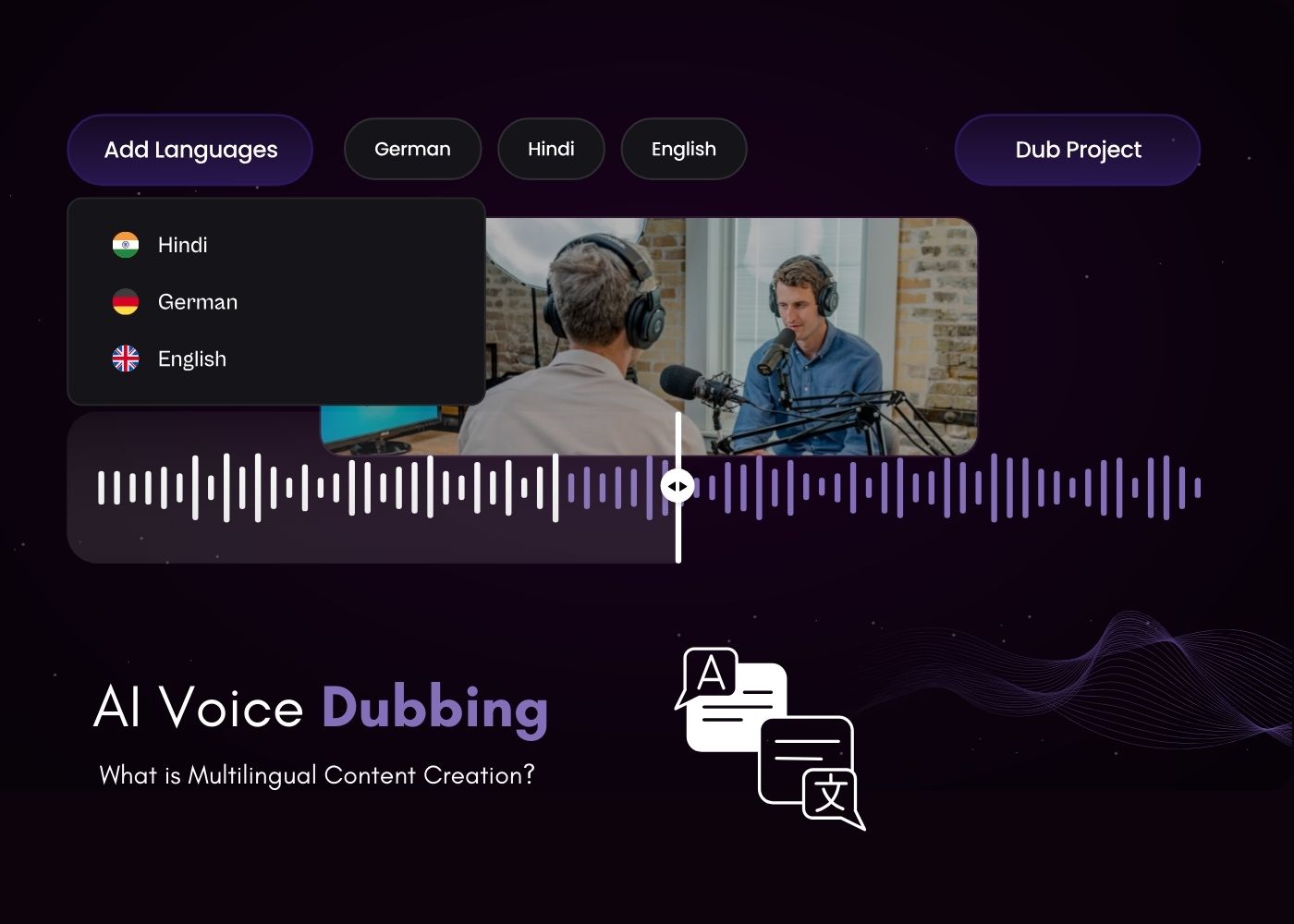In today’s globalized digital world, video is no longer just a medium for communication—it’s a powerful tool for connecting across languages, cultures, and borders. Whether you’re a content creator, marketer, educator, or business leader, your audience is no longer limited by geography. But with opportunity comes a challenge: language barriers. If your message isn’t understood, it won’t make an impact.
That’s where AI video dubbing comes into play. Instead of manually hiring voice actors or producing separate videos for each language, creators can now harness artificial intelligence to produce multilingual content faster, more efficiently, and at scale.
Why Multilingual Content Matters More Than Ever
The average internet user consumes video content daily—from social media reels to how-to guides and product demonstrations. And according to recent studies, videos in a viewer’s native language significantly increase comprehension, engagement, and emotional resonance.
This is particularly crucial in industries like education, marketing, and entertainment. For example, an online course in English may miss potential learners in Latin America or the Middle East. Similarly, a product demo meant for a global audience could see higher conversions if it’s presented in Spanish, Hindi, or French.
The Engagement Gap
One of the biggest hurdles for global content creators is ensuring their message doesn’t get lost in translation. Subtitles help, but they’re not always enough—especially on platforms where users multitask or scroll without reading. Dubbed videos provide a more immersive experience, allowing viewers to absorb content effortlessly and emotionally. That deeper connection drives engagement, shares, and ultimately, impact.
Enter AI Video Dubbing: A Smarter Solution
Thanks to advancements in artificial intelligence, creators no longer have to rely on time-consuming and expensive dubbing processes. AI video dubbing uses machine learning algorithms to analyze original speech, translate it into another language, and generate synthetic voiceovers that match the tone, pace, and context of the original speaker.
Tools like invideo AI have played a pivotal role in simplifying this process. With AI-driven dubbing solutions, creators can produce multilingual versions of their videos in minutes, not days. Whether it’s for YouTube content, online courses, social media clips, or business presentations, this technology allows for rapid localization—without compromising quality.
Key Benefits of AI Dubbing:
- Scalability: Create dubbed versions in multiple languages simultaneously.
- Cost-Efficiency: Avoid hiring voice actors or production teams.
- Speed: Turnaround time is drastically reduced.
- Consistency: Maintain a uniform tone and style across all videos.
- Inclusivity: Reach diverse audiences who prefer or need content in their native tongue.
How AI Video Dubbing Works Behind the Scenes
The process begins with speech recognition. The AI first transcribes the original audio into text. Then, using neural machine translation (NMT), the content is translated into the target language. Once the translation is finalized, the dubbing engine synthesizes a voiceover using advanced text-to-speech models that sound human and natural.
Some systems even offer facial alignment features, where the speaker’s lip movements adjust to match the dubbed audio, adding a layer of realism. This can be especially helpful in interview-style or instructional videos where visual authenticity matters.
Common Use Cases Across Industries
Let’s look at how different sectors are leveraging this technology:
1. Education & eLearning
Educators and course creators are increasingly turning to AI dubbing to localize their lessons. A science tutorial originally in English can now be shared in Mandarin, Arabic, or Portuguese—expanding its reach globally without re-recording.
2. Marketing & eCommerce
Multilingual product demos, testimonials, and ad campaigns benefit significantly from dubbed content. Consumers are more likely to trust and purchase products when the message feels native.
3. Entertainment & Streaming
Short films, documentaries, and YouTube series can easily be dubbed into multiple languages, helping creators break into new regional markets.
4. Corporate Communication
Companies can dub training materials, internal announcements, and client-facing presentations, ensuring consistent messaging across global teams.
Why AI Dubbing Beats Traditional Voiceovers
While traditional voiceovers may still hold value in high-end productions, AI dubbing offers unmatched speed, flexibility, and affordability. Instead of going through rounds of casting, recording, and editing, creators can test different voice options, adjust pronunciation, and publish within hours.
Additionally, for time-sensitive content—such as news updates, promotional videos, or social media announcements—AI dubbing offers real-time or near-instant results, which is invaluable.
The Role of AI Video Apps in the Dubbing Revolution
As demand grows, AI video apps are becoming more versatile and accessible. These tools are no longer limited to editing or trimming clips. Many now offer built-in dubbing, subtitling, translation, and even automated lip-syncing.
This convergence of features enables even solo creators or small teams to produce professional-grade multilingual content. What once required an entire post-production studio can now be done from a laptop.
AI Video Dubbing vs. Subtitles: What’s Better?
While subtitles are helpful, they depend on viewers reading along—something not always practical in mobile-first environments. Dubbed videos allow users to engage passively, which is crucial on platforms like TikTok, Instagram Reels, or YouTube Shorts, where attention spans are short.
Moreover, dubbed voices—especially when emotionally tuned—can enhance storytelling and audience connection. This is particularly important in brand storytelling, character-driven narratives, and education.
Best Practices for Using AI Dubbing Effectively
While AI makes dubbing easier, getting it right still requires strategy. Here are some tips to make your dubbed videos shine:
1. Start with Clear, Well-Structured Audio
The better your original audio quality and speech clarity, the more accurate the dubbing. Avoid background noise or overlapping voices.
2. Choose Languages Strategically
Don’t try to translate into every language. Focus on your key demographics. Analyze your traffic sources or audience analytics to decide which languages make the most sense.
3. Customize Voice Tone and Gender
Most AI dubbing platforms offer multiple voice options. Pick voices that reflect the tone of your message—formal for business, warm for education, energetic for entertainment.
4. Check Cultural Relevance
Machine translation can miss cultural nuances. Always review translated content or consult a native speaker for final tweaks.
5. Use AI Dubbing as Part of a Larger Localization Strategy
AI dubbing works best when paired with localized visuals, subtitles, and culturally relevant calls to action. Make sure the entire video feels tailored, not just the voice.
Future Trends: Where Is AI Dubbing Headed?
AI video dubbing is evolving rapidly. In the near future, we can expect:
- Real-Time Dubbing: Live translations for video calls, webinars, and live streams.
- Emotional Voice Synthesis: AI voices that express subtle emotions like sarcasm, empathy, or excitement.
- Accent Adaptation: Voices that not only translate language but adapt to regional accents.
- Avatar Integration: AI avatars combined with dubbing to create hyper-realistic virtual presenters.
These innovations will unlock new storytelling formats and redefine what it means to be a global content creator.
Final Thoughts
AI video dubbing is more than a tech trend—it’s a game-changer for communication. It empowers creators, educators, and businesses to break language barriers and connect with audiences in deeply personal ways. By integrating dubbing into your video production workflow, you not only expand your reach but also create a more inclusive and engaging viewing experience.
As AI video apps continue to evolve and push the boundaries of what’s possible, now is the perfect time to explore how multilingual video content can elevate your brand, message, or mission.





